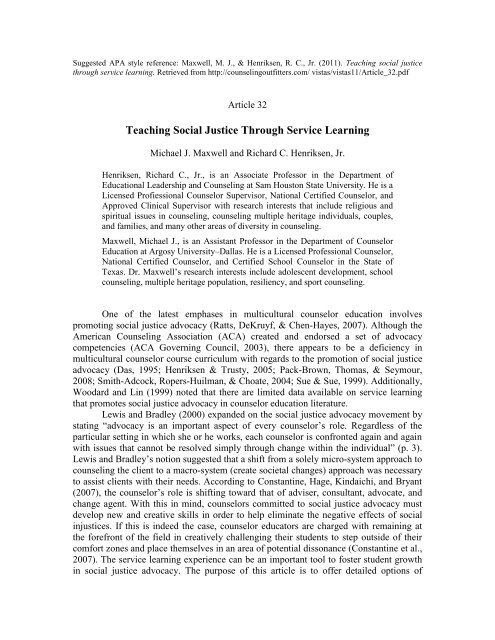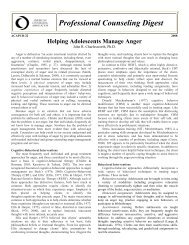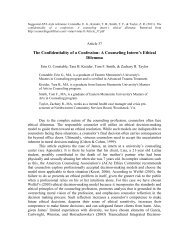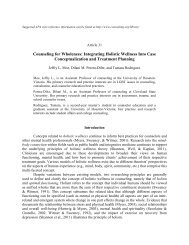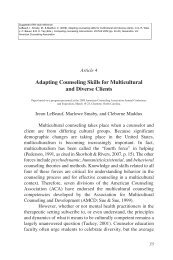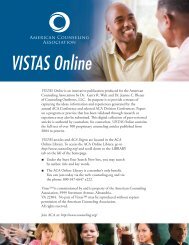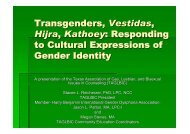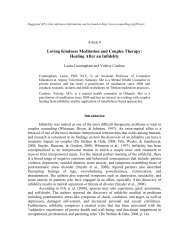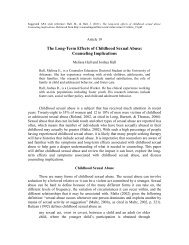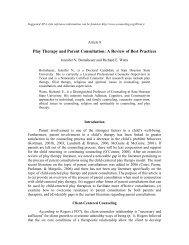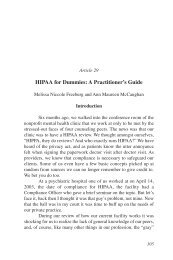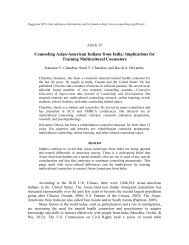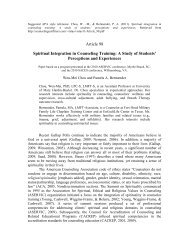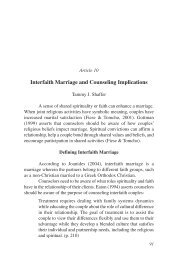Article 32. Teaching Social Justice Through Service Learning.
Article 32. Teaching Social Justice Through Service Learning.
Article 32. Teaching Social Justice Through Service Learning.
Create successful ePaper yourself
Turn your PDF publications into a flip-book with our unique Google optimized e-Paper software.
Suggested APA style reference: Maxwell, M. J., & Henriksen, R. C., Jr. (2011). <strong>Teaching</strong> social justicethrough service learning. Retrieved from http://counselingoutfitters.com/ vistas/vistas11/<strong>Article</strong>_<strong>32.</strong>pdf<strong>Article</strong> 32<strong>Teaching</strong> <strong>Social</strong> <strong>Justice</strong> <strong>Through</strong> <strong>Service</strong> <strong>Learning</strong>Michael J. Maxwell and Richard C. Henriksen, Jr.Henriksen, Richard C., Jr., is an Associate Professor in the Department ofEducational Leadership and Counseling at Sam Houston State University. He is aLicensed Profiessional Counselor Supervisor, National Certified Counselor, andApproved Clinical Supervisor with research interests that include religious andspiritual issues in counseling, counseling multiple heritage individuals, couples,and families, and many other areas of diversity in counseling.Maxwell, Michael J., is an Assistant Professor in the Department of CounselorEducation at Argosy University–Dallas. He is a Licensed Professional Counselor,National Certified Counselor, and Certified School Counselor in the State ofTexas. Dr. Maxwell’s research interests include adolescent development, schoolcounseling, multiple heritage population, resiliency, and sport counseling.One of the latest emphases in multicultural counselor education involvespromoting social justice advocacy (Ratts, DeKruyf, & Chen-Hayes, 2007). Although theAmerican Counseling Association (ACA) created and endorsed a set of advocacycompetencies (ACA Governing Council, 2003), there appears to be a deficiency inmulticultural counselor course curriculum with regards to the promotion of social justiceadvocacy (Das, 1995; Henriksen & Trusty, 2005; Pack-Brown, Thomas, & Seymour,2008; Smith-Adcock, Ropers-Huilman, & Choate, 2004; Sue & Sue, 1999). Additionally,Woodard and Lin (1999) noted that there are limited data available on service learningthat promotes social justice advocacy in counselor education literature.Lewis and Bradley (2000) expanded on the social justice advocacy movement bystating “advocacy is an important aspect of every counselor’s role. Regardless of theparticular setting in which she or he works, each counselor is confronted again and againwith issues that cannot be resolved simply through change within the individual” (p. 3).Lewis and Bradley’s notion suggested that a shift from a solely micro-system approach tocounseling the client to a macro-system (create societal changes) approach was necessaryto assist clients with their needs. According to Constantine, Hage, Kindaichi, and Bryant(2007), the counselor’s role is shifting toward that of adviser, consultant, advocate, andchange agent. With this in mind, counselors committed to social justice advocacy mustdevelop new and creative skills in order to help eliminate the negative effects of socialinjustices. If this is indeed the case, counselor educators are charged with remaining atthe forefront of the field in creatively challenging their students to step outside of theircomfort zones and place themselves in an area of potential dissonance (Constantine et al.,2007). The service learning experience can be an important tool to foster student growthin social justice advocacy. The purpose of this article is to offer detailed options of
Ideas and Research You Can Use: VISTAS 2011service learning activities that promote social justice advocacy among counselingstudents. This article suggests that the deficiency can be filled with a variety ofexperiential activities (Arman & Scherer, 2002; Burnett, Hamel, & Long, 2004; Gayles &Kelly, 2007; Henriksen, 2006; Roysircar, Gard, Hubbell, & Ortega, 2005).<strong>Social</strong> <strong>Justice</strong> DefinedZajda, Majhanovich, and Rust (2006) discussed the idea that the meaning ofsocial justice is often based on the definition used to define social justice, differingperspectives of social justice, and the theory used to define social justice. Crethar, TorresRivera, and Nash (2008) defined social justice counseling as “a unique and multifacetedapproach to mental health care in which counselors strive to promote human developmentand the common good by addressing issues related to both individual and distributivejustice” (p. 270). Gehart and Lucas (2007) stated that social justice advocacy from aclinical perspective involves “helping clients to address institutional and social barriersthat impede their ability to achieve goals or access needed services” (p. 40). Thesedefinitions provide the basis for understanding social justice advocacy from theperspective of the authors and point to the need for counselor educators and students tobecome more involved in service learning activities.<strong>Service</strong> <strong>Learning</strong> DefinedBringle and Hatcher (1995) defined service learning as a “credit-bearing,educational experience in which students participate in an organized service activity thatmeets identified community needs and reflect on the service activity in such a way as togain further understanding of course content, a broader appreciation of the discipline, andan enhanced sense of civic responsibility” (p. 112). <strong>Through</strong> service learning projects,students are able to gain knowledge about “the power dynamics behind the structural andinstitutional inequities that have been created around categories, such as gender,race/ethnicity, class, disability, age, and sexual orientation” (Prentice, 2007, p. 266).<strong>Service</strong> <strong>Learning</strong> Activities for Promoting <strong>Social</strong> <strong>Justice</strong> AdvocacyColeman (1998) stated “culturally neutral counseling does not exist” (p. 153).Counselors bring who they are to the counseling venue and this underlying driveencourages much of how the counseling relationship manifests. A well thought outmulticultural counseling curricula can act as a fertile garden for cultivating knowledge,skills, an appreciation, and advocacy for potential clients who may experience a form ofoppression within society. In their 1998 study on the perceptions of counselor trainees,Steward, Morales, and Bartell (1998) found that one-third of the students perceived thatan only literature-based course on multiculturalism was “meaningless.” Utilizing acurriculum that provides an experiential bridge between theory and practice appears to bea necessity for not only making multicultural counseling courses meaningful, but alsopromoting social justice advocacy. <strong>Through</strong> our review of the literature, we encounteredseveral intriguing variations for providing an experience-rich multicultural curriculum(Arman & Scherer, 2002; Burnett et al., 2004; Gayles & Kelly, 2007; Henriksen, 2006;2
Ideas and Research You Can Use: VISTAS 2011Roysircar et al., 2005). The programs that follow provide particular opportunities forcounseling students to experience their service learning activities within the milieu ofsocial justice advocacy.At this point, we think it important to delineate the difference between communityservice and service learning. According to Burnett et al. (2004), community serviceactivities imply a “missionary ideology” of working for the community or agency (p.181). Community service is volunteer work that aims to contribute to the welfare ofothers. On the other hand, Burnett, Long, and Horne (2005) went on to define servicelearning asa form of experiential education that directly involves the participant inthe phenomena being studied. The purpose of this method of instruction isto increase understanding of concepts studied in a classroom environmentby providing students with opportunities for direct exposure to problems,issues, and strengths of communities. (p. 158)<strong>Social</strong> learning, then, becomes more of an activity of working with an outside communityor agency in providing services and solutions for remedying social injustices (Burnett etal., 2005). A shift in the paradigm of thought is required when considering communityservice (clear and obvious power differential) and service learning (collaborative and asymbiotic give and take).<strong>Service</strong> learning activities help counseling students realize ACA’s advocacycompetencies, as well as the counseling profession’s plight for incorporating socialjustice advocacy training. Shrewsbury (1993) made reference to marrying classroomknowledge gained within the multicultural curricula to the service learning activity as theway to best promote social justice advocacy. Shrewsbury pointed out that what occurs is“a dialogue aimed not at disproving another person’s perspective, but at a mutualexploration of explications of diverse experiences” (p. 7). What follows is a review offive creative methods designed to promote social justice advocacy via service learningactivities.Mentoring ESL Students (MESLS)Roysircar et al. (2005) suggested graduate counseling students serve as mentors toEnglish as a Second Language (ESL) students. Serving ESL students at the elementaryand secondary school levels help counseling students gain direct experience in themulticultural needs of school-aged children of immigrant parents. ESL studentsexperience unique challenges due to their attendance in schools that may be foreign totheir native cultures (Vasquez & Vasquez, 2003).Roysircar et al. (2005) offered several suggestions for counseling students whenworking as mentors for ESL students. One suggestion is for the counseling trainee andESL student to do library or web searches on the student’s country of origin. This activitywill enable the ESL student to learn about and teach the counseling student informationabout his or her cultural background. Such a gesture helps to increase the self-esteem ofthe ESL student, which is recognized and affirmed by the counseling student (Roysircaret al., 2005).Another activity suggested by Roysircar et al. (2005) is for the counseling studentto engage in conversations about festivals, historical events, foods, traditions, andfamilial rituals. Roysircar et al. (2005) described an example of such an activity offered3
Ideas and Research You Can Use: VISTAS 2011by a counseling student:At the church service that R. [ESL student] attended on Ash Wednesday,prayer cards were given out. R. showed her card to me. The prayer on thecard was in Spanish, and I [counseling student] asked R. to first read it andthen translate it for me, which she did, teaching me some words in theprocess. I affirmed her faith in her religion, while thinking that I had notgiven much thought to my own. (p. 22)This type of conversation can be extended to social justice advocacy by thecounseling student mentor asking the ESL student mentee questions regardingwhat it is like for him or her experiencing a language barrier in their schools.After ensuring the ESL student’s confidentiality, the counseling student mentorcould share with the school’s administration what he or she learned from thementee regarding the mentee’s concerns. A concern that may arise might pertainto the discriminatory issues the ESL student experienced due to not speakingfluent English.For many counseling students, the MESLS service learning activity canserve as an initial opportunity to genuinely experience the ramifications of one’snative language in a society where the dominant language may be different.Roysircar et al. (2005) provided the following quote from a counseling student’sprocess notes:Until you have examined your reactions and reflections about yourown and others’ cultures, it is easy to think you have no biases.Feeling cultureless has allowed me to go through life ignoringpeople’s cultures. In these past few months, and in the process oftrying to learn about my ESL student, I have learned a profoundamount about myself. In one way or another, all of the readings,lectures, and articles came together as I reflected on my feelingsand tried to understand what was happening during my interactionswith my student. (p. 32)To sum up the MESLS service learning activity, the counseling studentscould create end-of-course presentations of their ESL student mentees’experiences of attending schools where the dominant language is different thanthe ESL students’ native languages. The counseling students could also include intheir presentations how they advocated for their mentees’ needs during theirmeetings with the school’s administration.Multicultural <strong>Learning</strong> Experience (MLE)Introduced by Henriksen (2006), the Multicultural <strong>Learning</strong> Experience (MLE) isa social justice service learning activity that promotes knowledge construction andprejudice reduction. This activity first requires the counseling student to identify anagency that serves clients that are culturally different than the student. The agency mustbe approved by the instructor. After approval of the service learning site, the student is toconduct an interview with the director of the chosen organization and discuss the purposeof the organization and any concerns the agency may have for the population it serves.Following the interview with the agency’s director or supervisor, the counseling4
Ideas and Research You Can Use: VISTAS 2011student is to complete a minimum of four hours of collaborative, volunteer service withthe agency. The service time at the agency must take place over two different days andmust involve direct interactions with the population served by the organization. Inaddition to the four hours of direct service with the agency, the counseling student is toobserve the usual operations of the agency, attend an orientation session with theorganization, interview the agency’s director, or a combination of these three activities.This additional requirement should take approximately two hours. The total amount oftime spent at the agency should be a minimum of six hours.To wrap up the MLE, the counseling students are to write a reaction paper abouttheir experiences at their respective service learning sites. The reaction paper shouldshow an integration of the concepts learned in the classroom setting (including readings,discussions, instruction, etc.) and the service learning site experience. Ultimately, thereaction paper should include a section that expresses the counseling students’transformed perceptions of social justice advocacy as a result of the MLE activity(Henriksen, 2006).National Coalition Building Institute (NCBI)The National Coalition Building Institute (NCBI; 2010) is an international, nonprofit,leadership training organization, started in 1984 to help eliminate racism and allother forms of prejudice and discrimination throughout the world. Gayles and Kelly(2007) suggested graduate students utilize this opportunity as a potential service learningexperience. Currently NCBI is made up of more than 100 teams in cities, universitycampuses, and organizations from around the world. If there is a pre-existing NCBIchapter on your campus, then counseling students could join the chapter, take onleadership roles, participate in sponsored events, and write reaction papers about theirexperiences. If there is no chapter on your campus, navigating the easy to follow, stepby-stepprocedure on how to start an affiliate group on the NCBI website can also be amajor project for a multicultural or social justice advocacy course activity. Once the newchapter is created, subsequent counseling students, who take the multicultural course, canmaintain the chapter as their major assignment. Periodic reaction papers can assist insolidifying the experience as a social justice building activity.A major component of NCBI’s (2010) opportunities is providing workshops andtraining sessions. These sessions generally are geared toward educating and training thoseinterested in leading an organization in a socially conscious fashion. Workshops caninvolve a variety of topics which include: Leadership for Diversity Institute, WelcomingDiversity/Prejudice Reduction Workshop, Welcoming Diversity Train-the-TrainerLeadership Clinic, Coalition Building Workshop, Controversial Issues Process,Controversial Issue Practicum, Controversial Issues Train-the-Trainer, ViolencePrevention Workshop, and Violence Prevention Train-the-Trainer (NCBI, 2010).Counseling students who utilize the NCBI (2010) model for satisfying theirservice learning social justice activity requirement can initiate or join an in-progressfaction that either brings to awareness or is bringing about non-discriminatory changes onthe campus, community, or international level. <strong>Through</strong> end of course presentations,counseling students could then report back to their classes their experiences within theNCBI organization and how specifically their membership or leadership contributed tobringing about social justice. Those classmates not associated with the NCBI5
Ideas and Research You Can Use: VISTAS 2011organization could learn how to promote social justice from an infrastructural level, viathe class presentations of their peers.School Counseling <strong>Service</strong> <strong>Learning</strong> Project<strong>Service</strong> learning is a teaching method where guided or classroom learning isdeepened through service to others in a process that provides structured time forreflection on the service experience and demonstration of the skills and knowledgeacquired. By definition service learning connects classroom content, literature, and skillsto community needs. As a result of completing a service learning project students willlearn to (a) apply academic, social and personal skills to improve the community; (b)make decisions that have real, not hypothetical, results; (c) grow as individuals, gainrespect for peers, and increase civic participation; (d) gain a deeper understanding of self,the community, and society; and (e) develop as leaders who take initiative, solveproblems, work as a team, and demonstrate their abilities through helping others (C.Parker, personal communication, October 19, 2010).<strong>Through</strong> the process of service learning, students engage in activities that caninvolve one of three types. First, Direct <strong>Service</strong>: students’ service directly affects andinvolves the recipients. The interactions are person-to-person and face-to-face, such astutoring younger children or working with parents related to prevention or intervention toenhance academic success (C. Parker, personal communication, October 19, 2010).<strong>Through</strong> the provision of direct services, students also learn about the social justice needsof those they serve as it relates to education and can move from direct service to socialjustice advocacy. Second, Indirect <strong>Service</strong>: indirect activities do not involve service toindividuals; however, these activities benefit the school, community or environment as awhole. One example might be conducting a workshop for faculty on classroom strategiesdesigned to help students as they prepare for success in college (C. Parker, personalcommunication, October 19, 2010). Helping underrepresented students gain entrance intocollege helps to meet one of the many social justice needs of culturally diversecommunities. Finally, Research: research activities involve students locating, gathering,and reporting on information in the public interest. For example, students may developsurveys or conduct formal studies, evaluations, experiments or interviews on leadershiptopics related to children, parents, teachers or other stakeholders (C. Parker, personalcommunication, October 19, 2010). The outcomes of the research can often lead to theidentification of social justice issues that could then lead to direct social justice advocacy.<strong>Service</strong> learning that includes a focus on social justice issues requires students tofollow a process so that learning and social justice advocacy is maximized (C. Parker,personal communication, October 19, 2010). Steps involved in social justice learninginclude preparation, action, reflection, and demonstration. Preparation involvesidentifying a need, investigating and analyzing it, and making a plan for action. Theprofessor and student will work together to set the stage for learning and social action.Action is the direct result of preparation. The plan developed during preparation is carriedout and is expected to involve no less than three hours of involvement. Reflection (in theform of a journal) is a vital and ongoing process in service learning that integrateslearning and experience with personal growth and awareness. Using reflection, studentsconsider how the experience, knowledge and skills they are acquiring relate to their ownlives and their communities; one entry per week is required. A reflection is a one page6
Ideas and Research You Can Use: VISTAS 2011double-spaced written comment that refers to the topic and expresses the student’sthoughts about past experiences or insights that have new meaning based on what isbeing learned. Reflections are designed to help students make better discussions orimprove relationships when working with people, in particular, those who are culturallydiverse. Finally Demonstration (Presenting/Evaluation) provides evidence of whatstudents have gained and accomplished through their community service learninginvolvement. Presenting will allow students to teach others and acknowledge whatinformation and skills have been learned. The result of this activity is that students learnthe importance of giving back to their communities and learn the meaning of socialjustice advocacy.<strong>Social</strong> Action: A Mandate for Counselors (SAMC)Rawlins (as cited in Henriksen, 2006) described an activity that is completed byboth faculty and students. This collaboration exemplifies the pressing need for all mentalhealth professionals and educators to embrace social justice promotion. SAMC differsfrom many traditional service learning activities in that it begins, as the first step, withstudents and faculty defining their roles in social justice advocacy. This involves preservicetime spent in the classroom, discussing the paradigm shift in thought regardinghow counselors take a collaborative stance as advocates instead of volunteers (Henriksen,2006).The second step in the SAMC preprocess, as illustrated by Rawlins (as cited inHenriksen, 2006), includes the actual volunteer service provided by the students out inthe selected community agencies. The unique element that distinguishes the SAMCproject is that the counseling student creates his or her own activities within the preexistingcommunity agency. The final step of the SAMC requires students to reunite intoa group counseling-type setting and discuss their service learning experiences with oneanother. With this step, each student is able to learn vicariously from one another’sservice learning experience, reflect upon how the experience may have transformed anyattitudes toward oppressed groups in society, and process through what it means tobecome an advocate for social justice (Henriksen, 2006).Implications for Counselor Educators and Counseling StudentsThe counselor’s most important tool is the use of self (Corey, 1996). To that end,the multicultural service learning experience can assist to enhance a counseling student’sself-esteem and increase social competence (Williams, 1990). The education ofmulticulturally sensitive counselors should include activities that generate an awarenessof ones’ own assumptions when working with others from a different culture (Das, 1995).The service learning activity not only increases the counseling student’s confidence whenworking with a client from a different culture, but can also help to generate a genuineconcern for the client’s welfare within the context of the oppressed. Counseling studentswho were trained under a strong multicultural program reported being more willing torecognize how cultural differences may have a bearing on their work (Parker, Moore, &Neimeyer, 1998).According to Burnette et al. (2005), service learning for counseling studentsprovides a meaningful experience that bridges educational theory with social justice7
Ideas and Research You Can Use: VISTAS 2011advocacy. Das (1995) stated that “each psychotherapy is thus a reflection of the culturethat produces it” (p. 49). Taking into consideration the aforementioned push by ACA(2003) to promote advocacy competencies gleams a glimmer of hope that the counselingcommunity will become a leader on the front towards eliminating social injustices.Tomorrow’s practicing counselors are in today’s counselor education programs.Experiences that require counseling students to submerge themselves into thecommunities and agencies that service the oppressed can help further along tomorrow’sleaders as social justice advocates.ReferencesAmerican Counseling Association Governing Council. (2003, March 20-22). 2003 ACAGoverning Council minutes. Anaheim, CA: Author. Retrieved fromhttp://www.counseling.org/Sub/Minutes/Governing_Council/2003_0320.pdfArman, J., & Scherer, D. (2002). <strong>Service</strong> learning in school counselor preparation: Aqualitative analysis. Journal of Humanistic Counseling, Education, andDevelopment, 41, 69-86.Bringle, R. G., & Hatcher, J. A. (1995). A service-learning curriculum for faculty.Michigan Journal of Community <strong>Service</strong> <strong>Learning</strong>, 2, 112–122.Burnett, J. A., Hamel, D., & Long, L. L. (2004). <strong>Service</strong> learning in graduate counseloreducation: Developing multicultural counseling competency. Journal ofMulticultural Counseling and Development, 32, 180-191.Burnett, J. A., Long, L. L., & Horne, H. L. (2005). <strong>Service</strong> learning for counselors:Integrating education, training, and the community. Journal of HumanisticCounseling, Education, and Development, 44, 158-167.Coleman, H. L. K. (1998). General and multicultural counseling competency: Apples andoranges? Journal of Multicultural Counseling and Development, 26, 147-156.Constantine, M. G., Hage, S. M., Kindaichi, M. M., & Bryant, R. M. (2007). <strong>Social</strong>justice and multicultural issues: Implications for the practice and training ofcounselors and counseling psychologists. Journal of Counseling andDevelopment, 85, 24-29.Corey, G. (1996). Theory and practice of counseling and psychotherapy (5th ed.). PacificGrove, CA: Brooks/Cole.Crethar, H. C., Torres Rivera, E., & Nash, S. (2008). In search of common threads:Linking multicultural, feminist, and social justice paradigms. Journal ofCounseling and Development, 86, 269-278.Das, A. K. (1995). Rethinking multicultural counseling: Implications for counseloreducation. Journal of Counseling and Development, 74, 45-52.Gayles, J. G., & Kelly, B. T. (2007). Experiences with diversity in the curriculum:Implications for graduate programs and student affairs practices. NationalAssociation of Student Personnel Administrators Journal, 44, 193-208.Gehart, D. R., & Lucas, B. M. (2007). Client advocacy in marriage and family therapy: Aqualitative case study. Journal of Family Psychotherapy, 18, 39-56.8
Ideas and Research You Can Use: VISTAS 2011Henriksen, R. C., Jr. (2006). Multicultural counselor preparation: A transformationalpedagogy. Journal of Humanistic Counseling, Education, and Development, 45,173-185.Henriksen, R. C., Jr., & Trusty, J. (2005). Ethics and values as major factors related tomulticultural aspects of counselor education. Counseling and Values, 49, 180-192.Lewis, J., & Bradley, L. (Eds.). (2000). Advocacy in counseling: Counselors, clients, andcommunity. Greensboro, NC: ERIC Clearinghouse on Counseling and Student<strong>Service</strong>s.National Coalition Building Institute. (2010). General information. Retrieved fromhttp://www.ncbi.org/Pack-Brown, S. P., Thomas, T. L., & Seymour, J. M. (2008). Infusing professional ethicsinto counselor education programs: A multicultural/social justice perspective.Journal of Counseling and Development, 86, 296-303.Parker, W. A., Moore, M. A., & Neimeyer, G. J. (1998). Altering white racial identityand interracial comfort through multicultural training. Journal of Counseling &Development, 76, 302-310.Prentice, M. (2007). <strong>Social</strong> justice through service learning: Community colleges asground zero. Equity & Excellent in Education, 40, 266-273. doi:10.1080/10665680701396735Ratts, M., DeKruyf, L., & Chen-Hayes, S. F. (2007). The ACA advocacy competencies:A social justice advocacy framework for professional school counselors.Professional School Counseling, 11(2), 90-96.Roysircar, G., Gard, G., Hubbell, R., & Ortega, M. (2005). Development of counselingtrainees’ multicultural awareness through mentoring English as a SecondLanguage students. Journal of Multicultural Counseling and Development, 33,17-36.Shrewsbury, C. M. (1993). What is feminist pedagogy? Women’s Studies Quarterly, 3(4),8-15Smith-Adcock, S., Ropers-Huilman, B., & Choate, L. H. (2004). Feminist teaching incounselor education: Promoting multicultural understanding. Journal ofMulticultural Counseling and Development, 32, 402-413.Steward, R. J., Morales, P. C., & Bartell, P. A. (1998). The multiculturally responsiveversus the multiculturally reactive: A study of perceptions of counselor trainees.Journal of Multicultural Counseling and Development, 26, 205-217.Sue, D. W., & Sue, D. (1999). Counseling the culturally different: Theory and practice(2nd ed.). New York, NY: Wiley.Vasquez, L. A., & Vasquez, E. G. (2003). <strong>Teaching</strong> multicultural competence incounseling curriculum. In W. M. Liu, R. L. Toporek, H. L. K. Coleman, & D. B.Pope-Edwards (Eds.), Handbook of multicultural competency in counseling andpsychology (pp. 546-551). Thousand Oaks, CA: Sage.Williams, R. (1990). The impact of field education on student development: Researchfindings. In J. C. Kendall & Associates (Eds.), Combining service and learning: Aresource book for community and public service (pp. 130-147). Raleigh, NC:National Society for Internships and Experiential Education.9
Ideas and Research You Can Use: VISTAS 2011Woodard, V. S., & Lin, Y. N. (1999). Designing a prepracticum for counselor educationprograms. Counselor Education and Supervision, 39, 134-145.Zajda, J., Majhanovich, S., & Rust, V. (2006) Introduction: Education and social justice.International Review of Education, 52, 9-22.Note: This paper is part of the annual VISTAS project sponsored by the American Counseling Association.Find more information on the project at: http://counselingoutfitters.com/vistas/VISTAS_Home.htm10


